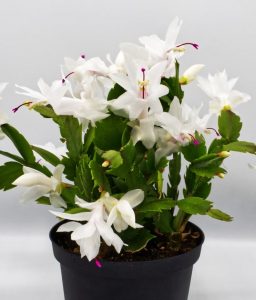If you’re looking to add a burst of color to your holiday decor, a blooming Christmas cactus (Schlumbergera) is the perfect choice. This stunning plant, with its vibrant pink, red, or white flowers, can bring a festive touch to your home during the winter months. However, getting a Christmas cactus to bloom can be tricky if you don’t know the right care techniques. In this guide, we’ll walk you through everything you need to know about how to make your Christmas cactus bloom and thrive.
Understanding the Christmas Cactus

Before diving into the care tips, it’s important to understand the basics of the Christmas cactus. Unlike many other cacti, which thrive in hot, dry environments, the Christmas cactus is native to the cool, tropical climates of Brazil. It grows on trees in rainforests, which means it prefers humidity and indirect sunlight. Unlike its desert cousins, it doesn’t need to be watered as frequently, and it doesn’t like extreme heat.
Step 1: Provide the Right Light Conditions
The first step in encouraging your Christmas cactus to bloom is ensuring it gets the right amount of light. Christmas cacti require a period of darkness to set buds and trigger blooming. Here’s how you can manage it:
- Light Cycle: Christmas cacti need about 12–14 hours of darkness each night for about 6 weeks to encourage flowering. During this period, make sure to keep your plant away from any light sources, such as streetlights, bright indoor lights, or even artificial lighting from your TV or computer.
- Daylight Exposure: During the day, place your cactus in a location with bright, indirect light. Avoid placing it in direct sunlight, as this can cause its leaves to burn.
Step 2: Maintain the Right Temperature
Temperature plays a crucial role in the blooming process of the Christmas cactus. To encourage blooming:
- Ideal Temperature for Blooming: Keep your cactus in a cool environment between 60°F and 65°F (15°C to 18°C). This is the ideal range for bud formation. Temperatures higher than this can delay blooming or cause the plant to shed its buds.
- Avoid Temperature Fluctuations: Try to avoid placing your Christmas cactus near drafts, heaters, or other temperature sources that could fluctuate rapidly.
Step 3: Watering and Humidity
Christmas cacti like their soil to be moist, but not soggy. Overwatering or underwatering can both prevent blooming and harm the plant. Here’s how to get the watering just right:
- Watering Schedule: Water your cactus when the top inch of soil feels dry to the touch. Avoid letting the plant sit in standing water, as this can lead to root rot.
- Humidity: Since Christmas cacti are native to tropical rainforests, they thrive in humid conditions. If you live in a dry climate, increase humidity by placing a tray of water near the plant or using a room humidifier.
- Avoid Fertilizing During Blooming Period: To encourage blooming, avoid fertilizing your Christmas cactus while it’s in the process of setting buds. Fertilizer can cause excessive growth at the expense of blooming.
Step 4: Use Proper Potting Mix
A well-draining potting mix is essential for a Christmas cactus. Use a mix that is light and allows water to flow through easily. A cactus mix combined with some orchid bark or perlite is a great option for promoting healthy root growth and avoiding water retention, which can lead to rot.
- Repotting: If your Christmas cactus has outgrown its pot or you notice it’s been a few years since repotting, it may be time to refresh its soil. However, avoid repotting during the blooming period, as this can stress the plant and reduce the chances of flowering.
Step 5: Inducing Blooming with a Rest Period
One of the keys to getting a Christmas cactus to bloom is giving it a period of dormancy. This is essentially a rest period where the plant stops growing and prepares for the upcoming blooming season. Here’s how you can induce dormancy:
- Rest Period: After the summer growing season, reduce the amount of water and place the cactus in a cooler, darker area. A closet or spare room with limited light works well.
- Duration: This rest period should last for about 6 weeks, after which you can return the plant to a brighter location and resume normal watering. During this time, don’t be alarmed if the cactus loses some of its leaves or appears to be dormant—this is normal.
Step 6: Post-Bloom Care
Once your Christmas cactus begins blooming, it will likely continue to flower for several weeks. To keep it healthy after blooming:
- Remove Dead Blooms: Gently pinch off any spent blooms to keep the plant looking tidy and encourage new growth.
- Continue Care: Keep watering as needed, and continue to provide bright, indirect light. Avoid moving the plant too much during the blooming period, as this can cause it to shed buds.
Troubleshooting: Why Isn’t My Christmas Cactus Blooming?
If your Christmas cactus is not blooming, here are a few common reasons and fixes:
- Too Much Light: If your cactus is exposed to artificial light or placed in a spot with too much sunlight, it may not enter its blooming cycle. Try moving it to a darker, cooler location at night.
- Wrong Temperature: If your cactus is too warm, it may not bloom. Aim to keep the temperature between 60°F and 65°F.
- Lack of Dormancy: If your plant didn’t get the right amount of rest or was fertilized too close to its blooming period, it may not bloom. Ensure it goes through a proper dormancy period with reduced water and light.
- Overwatering or Underwatering: Both can stress the plant, making it difficult to bloom. Make sure you’re following the correct watering schedule.
Final Thoughts
With the right care and patience, your Christmas cactus can bloom beautifully year after year, adding a festive touch to your holiday season. By ensuring proper light, temperature, and watering conditions—and by allowing the plant to undergo a rest period—you can enjoy vibrant flowers that brighten up your home in the winter months. Happy gardening, and may your Christmas cactus bloom in all its holiday glory!



